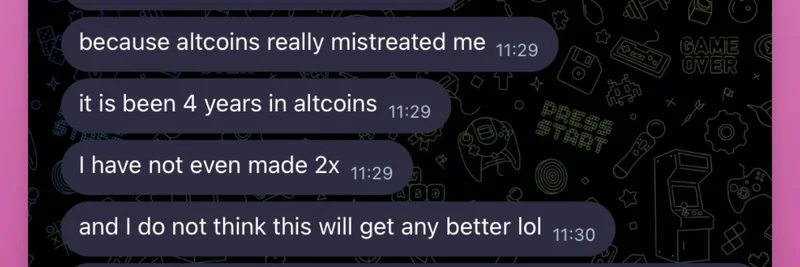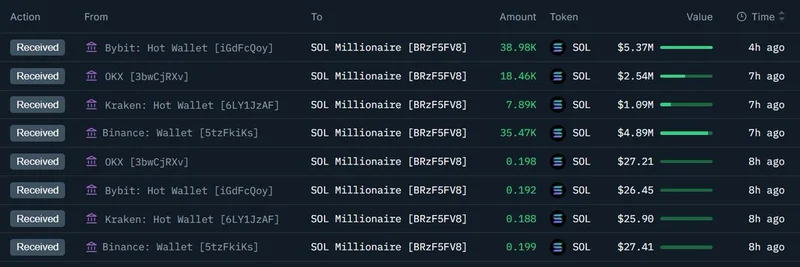In the fast-paced world of cryptocurrency, few things signal a market shift like widespread capitulation. Recently, DeFi analyst Ignas, known on X as @DefiIgnas, posted a thread highlighting the growing frustration among altcoin investors. His observations come at a time when many in the community are reevaluating their strategies, particularly in the memecoin sector.
Capitulation, for those new to crypto lingo, refers to the point where investors give up hope and sell their holdings at a loss, often marking the bottom of a downtrend. Ignas notes seeing this "full capitulation on alts across CT (Crypto Twitter) and in my DMs." He points out that many skipped Bitcoin early in the cycle, banking on the "old playbook" of altcoin rallies repeating past patterns.
Instead, new money flowed elsewhere, leaving holders of "old, boring tokens" in the dust. Investors got burned first on low-float, high-FDV (Fully Diluted Value) tokens—projects with limited circulating supply but massive total valuations that often lead to dumps. Then came the memecoin frenzy, where hype-driven assets promised quick gains but delivered volatility and losses for many.
As illustrated in one of the screenshots shared in the thread, a trader expresses exhaustion after four years in altcoins without even doubling their investment. They're planning to sell Ethereum (ETH), Solana (SOL), and possibly Pudgy Penguins (PP)—a popular NFT collection with meme appeal—into Bitcoin (BTC), holding onto BTC and a few Pudgies. This sentiment echoes broader disillusionment, with the trader joking about buying back ETH at $1,000 and SOL at $50, far below current levels.
Ignas also touches on "DAT trades," likely referring to data or AI-related tokens, which haven't fared better. Retail investors anticipated corporate adoption akin to Michael Saylor's Bitcoin strategy at MicroStrategy, but instead, they became "exit liquidity" for insiders—meaning they bought in just as early holders cashed out.
Shifting Altcoin Dynamics
Yet, amid the gloom, Ignas sees signs of change. The altcoin playbook is evolving: five of the top 10 lending apps are buying back their tokens, reducing supply and potentially boosting value. Protocols like Uniswap—a decentralized exchange—and Lido—a staking service for Ethereum—are activating "fee switches," mechanisms to distribute revenue to token holders.
This move towards rewarding holders could inspire other projects, but Ignas cautions it's no quick fix. Most altcoins lack real revenue to share, and even those with it remain overvalued based on metrics like P/E (Price-to-Earnings) ratios. As a result, alts are "repricing their speculative, 'new thing' premium" towards more sustainable valuations.
Another screenshot in the thread from @Cryptoyieldinfo reinforces this pivot: the user is "retiring" into 75% spot Bitcoin and 25% Ethereum, ditching alts and leverage entirely. They argue most DeFi yields aren't worth the risk right now, predicting a Bitcoin surge to $1 million someday.
Regulatory Catalyst on the Horizon
A key watchpoint, according to Ignas, is the CLARITY Act. This proposed legislation aims to provide regulatory clarity for cryptocurrencies, distinguishing between securities and commodities. While it won't greenlight pumps for all alts, it could usher in a regime change, creating new winners and losers in the space.
For memecoin enthusiasts, this thread is a sobering reminder. Memecoins, often fueled by community hype and viral trends rather than fundamentals, have been hit hard in this cycle. Projects like Pudgy Penguins have meme roots but are branching into NFTs and broader ecosystems. However, as capital concentrates on Bitcoin and established assets, meme tokens may need to demonstrate real utility or face further repricing.
Implications for Meme Token Investors
At Meme Insider, we track how these broader market shifts impact the meme economy. If top protocols are focusing on value accrual—sharing profits with holders—memecoin teams might follow suit. Imagine meme projects implementing buybacks or revenue shares from merchandise, games, or partnerships.
That said, the transition from pure speculation to sustainable models is "brutal," as one reply in the thread puts it, for the 95% of tokens without real users or revenue. With more tokens flooding the market than ever, attention and capital are spreading thin, exacerbating losses.
Replies to Ignas's thread echo these themes. One user doubts the CLARITY Act will save alts, while another highlights the irony: a 2x return in four years beats the S&P 500's typical 7-10 year doubling, yet feels like failure in crypto's high-stakes world.
As blockchain practitioners, staying informed on these trends is crucial. Whether you're holding memecoins or exploring DeFi, understanding capitulation phases can help time entries and exits better. For more on meme token strategies and the latest crypto news, check out our knowledge base.
What do you think— is this the end of the altcoin era, or just a reset? Share your thoughts in the comments below. For the full context, view the original thread on X.




